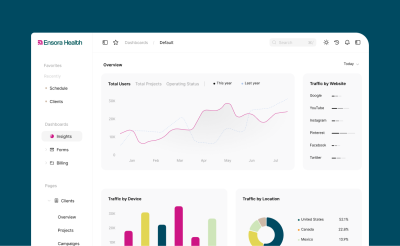Most common psychiatric controlled substances

The last few decades have seen a rise in illicit prescription drug use in the United States. The U.S. Department of Health and Human Services recognizes the opioid epidemic as a “public health emergency.” As a result, the government is actively working to battle this growing problem with mandates for the electronic prescribing of controlled substances (EPCS), designed to better monitor prescribing and significantly reduce opportunities for misuse.
While the mandates were specifically intended to curb the opioid crisis, they rope in all controlled substances, so you must be aware of them. This post reviews what you need to know and identifies the most common medications in the psychiatric controlled substances list.
How are controlled substances different from other prescription medications?
The Controlled Substances Act (CSA) controls certain substances and places those previously regulated under existing federal law into one of five schedules. At a high level, the categorization is based on how potentially dangerous they are. More specifically, it takes into account the substance’s medical use, the potential for abuse, and dependence or safety liability. This categorization of drugs has been carefully considered and is based on research from many different sources to determine the drugs’ potential harmfulness. Laws have been put in place to protect people from the harm they can do to themselves or others.
Five schedules of drugs
Drugs, certain chemicals, and the substances used to make them are grouped into five distinct schedules based on the drug’s acceptable medical use and the potential for abuse and dependency. Out of the factors considered for classification, the potential for abuse and the abuse rate are most significant. Schedule I drugs have the highest potential for abuse and dependency — whether it be psychological dependence, physical, or both — and Schedule V drugs have the lowest. While various organizations have categorized drugs into different systems, the five schedules of drugs referenced in this post are the DEA (Drug Enforcement Agency) groupings used to categorize drugs with a high potential for abuse.
Schedule I
Drugs with the highest potential for abuse are categorized as Schedule I drugs. There is no federally accepted medical use approved for treatment in the United States for these drugs. As a result, these drugs are considered unsafe for use, even under medical supervision. Some examples of Schedule I substances include heroin, lysergic acid diethylamide (LSD), and gamma-hydroxybutyric acid (GHB, also known as the “date rape” drug). Marijuana is also a Schedule I substance — even though more than half of the states have legalized its use, it is still not approved at a federal level.
Another drug that’s still a Schedule I substance but is gaining significant momentum in recent years is psilocybin, the active compound found in “magic mushrooms” or psychedelic mushrooms. In 2020, the FDA granted psilocybin “breakthrough therapy” status for the treatment of depression, which allows for expedited development and review of the substance for potential medical use. Some jurisdictions in the United States have begun decriminalizing or creating frameworks for therapeutic use of psilocybin, though these remain in conflict with federal law.
Schedule II
Schedule II drugs also have a high potential for abuse. However, they are different from Schedule I drugs in that they currently have an acceptable medical use in treatment in the United States, though sometimes with severe restrictions. The use of schedule II drugs may lead to severe physical or psychological dependence. Schedule II drugs include morphine, methadone, phencyclidine (PCP), and methamphetamine (meth).
Schedule III
These drugs have a currently accepted medical use in treatment in the United States, with less potential for abuse than the schedule I and II drugs and substances. Abuse of Schedule II drugs may lead to high psychological dependence and moderate or low physical dependence. Some examples of Schedule III drugs include codeine, anabolic steroids, hydrocodone with Tylenol or aspirin, and some barbiturates.
Schedule IV
Schedule IV substances have a currently accepted medical use in treatment in the United States. They also have a low potential for abuse relative to the Schedule I, II, and III drugs and substances. Abuse may lead to limited psychological and physical dependence relative to the drugs in the higher schedules. Examples of Schedule IV drugs include Valium, Xanax, and Equanil.
Schedule V
The last schedule of drugs, Schedule V, has a low potential for abuse relative to the other scheduled drugs. Abuse may lead to limited dependency, physically or psychologically, relative to the other scheduled substances or drugs. These drugs also do have an accepted medical use in treatment in the United States. Cough medicines with codeine is an example of a Schedule V drug.
Controlled substances listing
The DEA organizes its list of controlled substances in alphabetical order, with their branded and generic names as well as their schedule classification. It includes the parent chemical, but doesn’t always include the components and other substances that may be classified as controlled substances (things like salts, isomers, ethers, and derivatives).
List of the most common psychiatric controlled substances
There are several psychiatric controlled substances, with the most commonly prescribed being those for anxiety and ADHD.
Benzodiazepines (Schedule IV)
Benzodiazepines help reduce anxiety, including panic attacks or extreme worry and fear. They are the most common anti-anxiety medications used. Examples of these medications include:
- Klonopin (Clonazepam)
- Xanax (Alprazolam)
- Ativan (Lorazepam)
- Valium (Diazepam)
- Librium (Chlordiazepoxide)
- Restoril (Temazepam)
- Halcion (Triazolam)
These are schedule IV substances categorized with a low potential for abuse due to limited physical and psychological dependency. Even so, they are scheduled drugs subject to electronic prescribing of controlled substances (EPCS) mandates.
Stimulants (Schedule II)
Stimulants can treat Attention Deficit Hyperactivity Disorder (ADHD) in children and adults, and they are Schedule II substances. They have a high potential for abuse and may lead to severe psychological and/or physical dependence. They include:
- Ritalin or Concerta (Methylphenidate)
- Adderall (Dextroamphetamine and Amphetamine)
- Vyvanse (Lisdexamfetamine Dimesylate)
- Dexedrine (Dextroamphetamine)
- Focalin (Dexmethylphenidate)
- Desoxyn (Methamphetamine hydrochloride)
Sedative and hypnotics (Schedule IV)
These medications are primarily used for insomnia and sleep disorders, with a low potential for abuse due to limited physical and psychological dependency:
- Ambien (Zolpidem)
- Lunesta (Eszopiclone)
- Sonata (Zaleplon)
Barbiturates (Schedule II-IV)
Though less commonly prescribed today due to safety concerns, these medications are still used for certain conditions:
- Seconal (Secobarbital) – Schedule II
- Amytal (Amobarbital) – Schedule II
- Phenobarbital – Schedule IV
- Butisol (Butabarbital) – Schedule III
Opioid analgesics used in psychiatry (Schedule II-IV)
Sometimes used for treatment-resistant depression or in psychiatric pain management, with a high potential for abuse and dependence:
- Suboxone (Buprenorphine/Naloxone) – Schedule III
- Tramadol – Schedule IV
Other notable psychiatric controlled substances
- Ketamine (Schedule III) – Used for treatment-resistant depression
- Lyrica (Pregabalin) – Schedule V, used for anxiety and neuropathic pain
- Testosterone (Schedule III) – Sometimes used in gender-affirming care
- Anabolic steroids (Schedule III) – Can have psychiatric effects and abuse potential
- Psilocybin (Schedule I) – Researched for treatment-resistant depression, anxiety in terminal illness, substance use disorders, and PTSD.
Controlled substances certainly have a place for use in psychiatry, as they can provide significant relief. However, they must be carefully prescribed and monitored to reduce the risk of misuse. It’s essential to know the EPCS mandates and to be familiar with the levels of risk in prescribing these substances to ensure the well-being of your clients and your practice.






